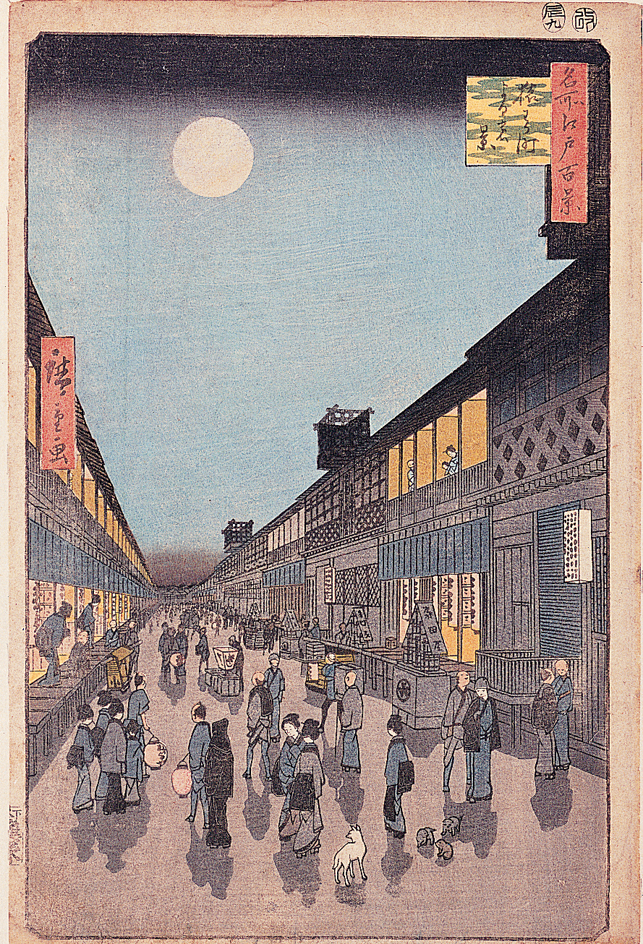Japanese print is a type of Japanese illustration printed on paper from carved blocks of wood. The most famous Japanese prints were produced from the 1600’s to the late 1800’s. They are noted for their brilliant designs, bold colors, and technical quality.

Most Japanese prints portray scenes from everyday life or from the theater and other popular forms of entertainment. The Japanese referred to these fleeting moments of life and passing amusements as the “floating world.” They called the prints ukiyo-e, which means pictures of the floating world.
Printing techniques
Japanese prints were designed by highly trained artists and produced by skilled artisans. The early prints were made in black and white, though the artists sometimes added other colors by hand. The Japanese began to produce color prints in the mid-1700’s.
Black-and-white prints were made from one block of wood. First, the artist drew a design in ink on paper. The drawing was glued onto a block of hardwood, usually cherrywood. A carver cut away the portions of the wood between the lines of the drawing, which left the design itself raised. A printer then applied a water-based ink to the raised surfaces of the wood block. A piece of absorbent paper was placed on the inked block. The printer rubbed the back of the paper with a smooth-surfaced pad, and the ink soaked into the paper. The printer then pulled the paper from the block, and the design appeared in print. The block could be used repeatedly to make hundreds of prints.

The production of color prints required additional blocks of wood, one for each color used. The carver cut each block so that the only areas left raised were those to be used for a certain color. The printer then applied various colored pastes to the blocks and placed the paper on each block in succession.
History
Japanese prints originated in the early 1600’s as illustrations in popular books. Many people became interested in the pictures themselves, and so publishers began to produce the illustrations separately from books. The publishers commissioned the artists and hired the carvers and printers.
Printmaking flourished in Japan during the Tokugawa period of the nation’s history, which lasted from 1603 to 1867. During this period, a middle class arose and prospered in Japan’s cities. The people of the middle class were the chief buyers of Japanese prints, which served as inexpensive substitutes for paintings. Japan had little contact with other countries during the Tokugawa period. Thus, Japanese print artists were not influenced by Western art styles. These artists followed Japanese art styles that had developed over centuries.
The master print artists.
One of the earliest known Japanese print artists was Moronobu, who lived during the 1600’s. He created black-and-white prints of scenes from everyday life.
A technique that enabled artists to create color prints was introduced in the mid-1700’s. This technique involved carving wood blocks with guide marks so that printers could place paper in the same position on successive blocks. Harunobu, an artist of the mid-1700’s, helped popularize color prints. His prints feature doll-like human figures and peaceful settings. They are noted for their beautiful colors and delicate lines.
Utamaro Kitagawa and Sharaku were among the greatest print artists of the late 1700’s. Utamaro Kitagawa was especially known for his portraits of beautiful women. Sharaku specialized in portraits of kabuki actors. Kabuki is a form of Japanese drama that developed in the 1600’s. His portraits have the exaggerated features typical of caricatures.
Landscape prints became popular in Japan during the 1800’s. Hokusai and Hiroshige designed magnificent landscape prints. These artists created many series of prints of a particular scene in nature under a variety of weather conditions.

The decline of printmaking.
During the mid-1800’s, the Tokugawa government became weakened by economic problems and social upheavals. The shogun (military ruler) resigned in 1867, and Emperor Mutsuhito officially became ruler in 1868. The new government began to modernize Japan and introduced many Western inventions and traditions into the country.
The drive for modernization led to the decline of traditional Japanese printmaking. Many Japanese artists adopted Western-style painting, and they produced few high-quality prints. In the 1920’s, interest in printmaking returned in Japan. Since then, Japanese woodcut artists have followed Western styles and techniques.
Japanese prints had a great influence on many European and American artists of the late 1800’s, including Edgar Degas of France and James A. M. Whistler of the United States. These artists sought alternatives to Western art styles and were fascinated by the unusual designs, bold colors, and pictorial conventions of Japanese prints.
